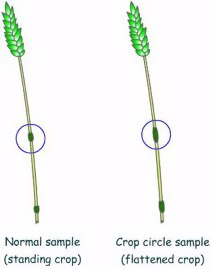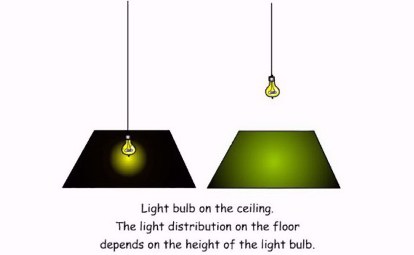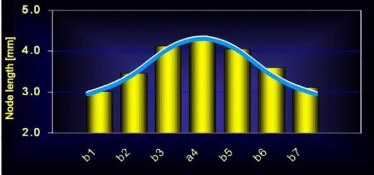THIS ARTICLE IS FREE OF COPYRIGHTS AND MAY BE COPIED AND DISTRIBUTED FREELY
Over the years, numerous people have claimed that they have seen how a crop circle was created by one or more "balls of light". Recent scientific studies have confirmed these statements: Circumstantial evidence has shown that crop circles may very well be made by 'balls of light' indeed! This article explains the essential elements of these studies in simple terms.
The stems of corn-type plants are characterised by little "knuckles," at several positions along the stems (see Figure 1). These nodes act as a kind of ligament. They allow the plants to bend towards the light, even after they have grown to their full length.

In the early 1990s, the American biophysicist William Levengood discovered that plants inside crop circles often had much longer nodes than those in the undisturbed, surrounding crop. This effect is illustrated in Figure 2.

Although there are known biological effects that can create node lengthening, these could be easily ruled out. It was clear that something else had happened. The effect could be simulated by placing normal, healthy stems inside a microwave oven. The heat induced by the microwaves made the liquids inside the nodes expand, just like the mercury inside a thermometer. This caused the nodes to increase in length, while the amount of lengthening increased proportionally to the amount of microwave energy that was generated.
This finding led to the conclusion that the node lengthening effect may be caused by the involvement of heat, possibly caused by microwave radiation. In fact, traces of heat have been found innumerable times in crop circles all over the world, such as dehydrated plants, burn marks, and molten snow.
The number of 'balls of light' that have been seen by eyewitnesses has increased considerably over the last couple of years. Sized somewhere between an egg and a football, these bright, fluorescent, flying light objects seem to be somehow related to the crop circle phenomenon. They often appear in the fields during the night a crop circle forms, and have been seen (and filmed!) many times in and around crop circles. Several persons have even claimed that they witnessed how these balls of light actually created a crop circle.
In the year 1999, William Levengood and Nancy Talbott published a scientific paper [1] that contained a study to the node lengthening effect in three different crop circles, two in England and one in the USA. The authors presented a 'quantitative analysis'; in other words, the article tried to explain the AMOUNT of node lengthening throughout the crop circle, by means of physical models. The authors concluded that the heat (that had made the nodes swell) was electromagnetic in origin.
One year later, I contributed a paper reacting to the one by Levengood and Talbott. This article appeared early 2001 [2]. The paper reinterpreted the data published by Levengood and Talbott and showed that the node lengthening as measured in all three crop circles could be perfectly explained by assuming that a 'ball of light' had caused the node swelling effect. An identical analysis performed on a famous man-made formation (Dreischor, Holland, 1997) did not show these characteristics at all.
My statements can be interpreted as follows: Imagine a dark room with one single light bulb hanging on the ceiling. If you switch on the light, you will notice that right below the light bulb the light intensity on the floor will be brightest. Towards the edges of the room, the floor will gradually become darker. This light distribution on the floor is well understood, and can be described with high accuracy.
The exact light distribution on the floor depends on the HEIGHT of the light bulb. When the light bulb is hanging very low, almost touching the floor, the floor underneath the light bulb will be very bright, but the intensity will rapidly become less as you move away from it (see Figure 3, left). When the light is hanging high on the ceiling, however, the light intensity underneath the light will be much less and be more evenly distributed over the floor (see Figure 3, right). Because this mechanism is so well known, one can actually derive the height of the light bulb after measuring the light distribution on the floor.

This is what I suggested. As explained above, the swollen nodes inside the crop circles may be thought of as many little thermometers, expanding their length with increasing heat. If one assumes that the heat was induced by a small spherical shape emitting electromagnetic radiation, the theoretical heat distribution on the floor can be accurately determined (similarly to the case of the light bulb, as discussed above). I demonstrated that the measured node lengths in all of the three crop circles studies by Levengood and Talbott perfectly matched the temperature distribution that would be caused by a small ball of light, hanging in the air above the centre of the circles, emitting intense heat.
An identical analysis was repeated on a formation in Holland [3]. An eye witness claimed that this crop circle was created in a matter of seconds, while a "ball of light" was floating in the air, right above the centre of the circle [4]. Figure 4 shows the results.

The yellow bars indicate the average node length measured at seven different locations across the crop circle, from one edge (position b1), through the centre (a4), to the opposite edge (b7). Note the perfect symmetry, which is remarkable! Similar graphs were obtained from two different cross sections through the circle, revealing a perfect circular symmetry: long nodes towards the centre of the circle, shorter nodes towards the edges.
The thick, continuous, blueish line represents the theoretical value of the node length across the circle, if it were caused by a ball of light at a height of 4 meters and 10 centimetres. (This height corresponded to the estimate of the eyewitness). Just like the three crop circles analysed by Levengood and Talbott, the theoretical values for the node length (blue line) correspond perfectly to the measurements (yellow bars).
Consequently, the circumstantial evidence left in the fields was in perfect agreement with the words of the eyewitness: the crop circle was indeed created with the involvement of a "ball of light".
My paper shows that the node lengthening in several crop circles corresponds perfectly to the effect that would be created by a ball of light, heating up the crop during the creation of the crop circle. This is not the case for a man-made formation.
The amount of node lengthening, and in particular its symmetry over the crop circles, lack any trivial explanation. Consequently, the study confirms the words of eyewitnesses, stating that they saw how crop circles were created by "balls of light."
My paper does not attempt to explain where the balls of light come from, nor does it explain how the crop is flattened. It does, however, give a strong argument to take the "ball of light" phenomenon, as well as the words of eyewitnesses, very seriously, and I hope will stimulate further study.
Finally, it should be mentioned that all these findings and conclusions have been published in 'peer-reviewed' scientific journals. In order to guarantee a high level of reliability, such journals employ so-called 'referees' (objective, anonymous experts), who accurately check each contributed paper for errors and inconsistencies before it is published. Consequently, conclusions published in peer-reviewed scientific journals can not be simply dismissed as wild fantasy or pseudo-science. Therefore, it is fair to say that recent scientific findings have established considerable progress in understanding the crop circle phenomenon, although many questions still remain unanswered.
Note: this text is for reference. My opinion on the work and its conclusions is here.